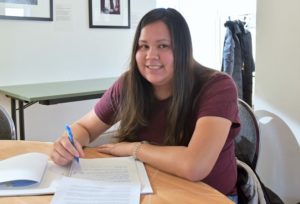Nipissing University students share treaty knowledge with community

By Kelly Anne Smith
NORTH BAY—Nipissing University students shared treaty knowledge with the community in a special public lecture held at the North Bay Museum Jan. 30.
As part of the course History 3147, Dr. Murton Stoehr presented the lecture Upper Canada Treaties: Land Surrenders or Reserves for Loyalists. In offering lectures to Nipissing and Dokis First Nation citizens as well as in universities, Murton Stoehr hopes to repatriate knowledge held in the universities.
Students of History 3147 have been adventurous. Their first class was held at Nbisiing High School in Duchesnay Village in Nipissing First Nation to learn Treaty Words from Dr. Mary Ann Naokwegijtg-Corbiere.
“The real story is that the class is sharing with the community at the North Bay Museum.”
Murton Stoehr adds that she was confident approaching the North Bay Museum to share their space because they have shown a commitment to reconciliation.
The lecture room has windows facing downtown North Bay while the other windows face Lake Nipissing. Murton Stoehr told her students that she appreciates sharing the knowledge with people on either side of the treaties.
“I want to acknowledge that we are on the land of Nipissing First Nation,” shared Murton Stoehr. “This is Robinson Huron Treaty land, and that treaty is being kept very much on one side, and not on the other. I’m happy to be accountable about what I have personally done to uphold that treaty to any of my treaty partners in the room in a later conversation.”
Caution was given.
“To the non-Indigenous people in the room, you may have emotional impulses that pull you away from the story that I’m telling. I have those reactions, too. You’ll have to just sit with that. For my treaty partners in the room, the project of colonialism interrupted the mechanisms that held this story in the communities, so the processes of memory and history in First Nations across the territory were interrupted by unrelenting assaults that continue to this day. These stories have been violently withheld from you.”
Many students were surprised to hear they were on treaty land and that there are 46 treaties throughout Ontario.
Most students answered ‘no’ when asked if anyone heard about the treaty topic.
“You were never taught it,” Murton Stoehr replied. “The colonial school system has actively forgotten these treaties.”
Murton Stoehr calls treaties living documents with practical implications. She explains that at first, the treaty negotiations followed Indigenous protocols. Condolence ceremonies were held and presents given not as payments for land, but to atone for any missteps in the relationship and to maintain alliances.
Murton Stoehr says the Upper Canada treaties were negotiated under threat of subsistence interruption, personal violence, political subjugation, and genocide.
Nipissing First Nation was instrumental in what Dr. Murton Stoehr argues is the main treaty that established the legal environment for all of the subsequent land sharing agreements, the Treaty of Niagara.
In 1764, Sir William Johnson gave strings of wampum to Nipissing First Nation to reach out to allies and to meet in Niagara. 24 Nations from the Haudenosaunee, Seneca, Wyandot of Detroit, Menominee, Algonquin, Ojibwa, Mississaugas, and others who were part of the Seven Nations of Canada and the Western Lakes Confederacy joined the Nbisiing in signing.
It was not until 1923 and Treaty #20 concerning Rice Lake, was the right to hunt included in a treaty. This was not because the Crown had become more generous, the right to fish and hunt had always resided with First Nations. It had to be written into the treaties because settlers were violating it.
“All of those treaties that got negotiated, they still hold in the Canadian courts,” said Murton Stoehr.
She concluded by reading Peter Jones, a Mississauga.
“Our fathers held out to them a hand of friendship. The strangers then asked for a small piece of land on which they might pitch their tents and the request was cheerfully granted. By and by, they begged for more and more was given to them. In this way they had continued to ask or obtain by force or fraud the fairest portions of our country.”
Nipissing First Nation interdisciplinary artist and writer Aylan Couchie took research notes.
“A lot of my work in the last two or three years has revolved around the idea that monuments are a colonial object of erasure of Indigenous presence. Within that, thinking about land acknowledgements and ways to reinsert Indigenous presence as land acknowledgements through monuments and public art. My work is organically coming to a spot where treaty has to be part of it.”
After the lecture, student Rutanya Iserhoff was sad thinking about what First Nations Peoples went through. She lives in Timmins and is from Fort Albany First Nation. Majoring in Criminal Justice at Nipissing University, Iserhoff was interested when the course first became available.
“There’s not a lot of opportunities to learn about treaties. You have to study on your own and research it,” expressed Iserhoff. “I’m glad I learned this. I had a vague picture at first, but now I know what really happened. It’s opened my eyes, how the land was negotiated. They wanted to share it and for everybody to get along. And then it was taken away. How they were treated – I feel for them.”
Iserhoff questions why she had to learn global history in elementary school.
“What about our history that needs to be taught?”
“If people understand this, they will have a better understanding of what’s going on, why the native people are going through such hardships,” continued Iserhoff. “People don’t know. This needs to be taught in elementary school”, insisted Iserhoff.


